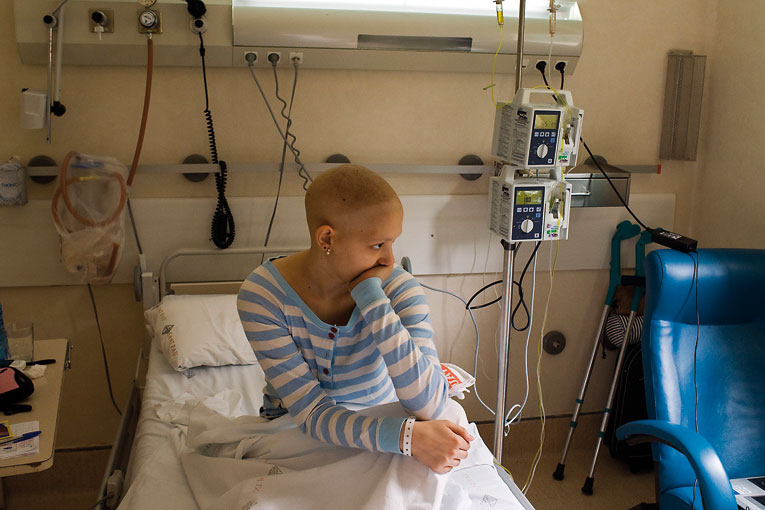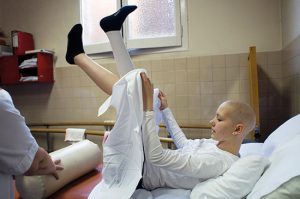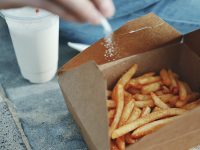Teenagers with cancer
A challenge to the system

ABSTRACT
For teenagers, to be diagnosed with cancer comes as a real blow. In this article, we describe the most prevalent cancers in this age group, the elements of cancer control, the effects on the adolescent patient and the challenges faced by the health system to provide comprehensive care. Certain organisations exist, which play a fundamental role in helping adolescents with cancer not to give up, and to keep up a fighting spirit.
Keywords: adolescence, cancer, heath-care challenges.
Adolescence, encompassing the fifteen to nineteen year age group (Ries et al., 1999), is considered to be a well defined stage in life, with its own characteristics. That is why this period should not be seen as a preparatory stage of adulthood alone, but as an important stage in terms of personal development.
If being a teenager is not easy in itself, then cancer diagnosis complicates things even more. Iris García (Valerio, 2009), psycho-oncologist at the AECC (Spanish Association Against Cancer) summarises adolescence as «a special time of life, in which one begins to develop a personal identity». In this context, cancer represents a blow in many respects.
We cannot ignore the challenge that cancer in adolescence poses to the health system. Despite the large number of cancers diagnosed in this age group, not all Spanish hospitals have specialised units to cater for them.
INCIDENCE AND MORTALITY
In Spain, in the adolescent population the incidence of cancer is 200 cases per million adolescents per year. Although adolescent cancer represents only 1% of the total, it is the second leading cause of death in this age group. There are certain factors that may predispose adolescents to developing tumours, such as infections, hormonal and growth processes, and exposure to certain contaminants.
«Being a teenager is not easy in itself and cancer comes as a real blow»
Lassaletta, oncologist at the Niño Jesús Hospital in Madrid specialising in adolescents, states that «while in the last fifty years survival of adult and childhood cancer has improved dramatically; it has come to a standstill in adolescents and youths» (EFE, 2012). He primarily blames this on the fact there are no referral hospitals, specialists, treatments or clinical trials for this age group in Spain.
TYPES OF CANCER AFFECTING ADOLESCENTS
There are certain cancers for which incidence reaches the highest peak between thirteen and twenty-four years of age (Teens Health, 1995-2013). We summarise the most characteristic below.

Tino Soriano
Osteosarcoma
This is the most common bone cancer affecting young people. It is more common at the ends of long bones such as the tibia, femur and the proximal humerus. The most common symptoms are fractures, pain and local inflammation, and some functional disability. The tumour can spread to the lungs or other bones. Treatment usually involves chemotherapy and surgery (removal of the tumour or bone affected by cancer). Sometimes it requires partial or complete amputation of the affected limb. Losing a limb can be a tremendously shocking experience, especially for teenagers, who are facing many physical changes. In these cases of extreme surgery, prosthesis can be fitted, and most teenagers can resume normal everyday activities, including sports.
Ewing’s Sarcoma
This is another bone cancer that usually affects the legs or pelvis. Most adolescents with Ewing’s sarcoma receive chemotherapy and many also undergo surgical treatment. Some patients also require radiation therapy. Ewing’s sarcoma usually responds well to chemotherapy and radiotherapy. The chances of recovery from both bone cancers depend on tumour location, size and whether metastasis occurs. Generally they respond well to treatment and can be cured in many cases.
«Treatment should preferably be carried out at special units for adolescents and psychological support services are essential but health-care support services do not cater for adolescents »
Leukaemia
Leukaemia (blood cancer) is one of the most common cancers in children. It causes several problems, such as haemorrhaging, anaemia, bone pain and infections. It may spread to the lymph nodes, liver, spleen, brain and testes. The most common types of leukaemia in adolescence are acute lymphocytic leukaemia and acute myeloid leukaemia. Treatment includes chemotherapy and sometimes radiotherapy too. Bone-marrow transplants are another treatment option. The chances of cure are high in certain types of leukaemia and without future relapse.
Cerebral Tumours
The most common are astrocytomas and ependymomas. Surgery is usually performed if it is possible to remove the tumours, followed by radiotherapy. Some patients also receive chemotherapy. If the tumour can be removed and additional treatment is given, the chances of recovery are high.

A teenager with cancer receives guidance at Premià de Mar (Barcelona), photographic series «David versus Goliath» (2010). Hospital routines take teenagers away from the classroom and classmates for many months.
Lymphoma
Lymphoma develops in the lymphatic system, which includes the lymph nodes, thymus, spleen, adenoids, tonsils and bone marrow. Adolescents with lymphoma can suffer either Hodgkin’s lymphoma (or Hodgkin’s disease) or non-Hodgkin lymphoma. Hodgkin’s disease may appear in the lymph nodes in the neck, armpit, chest or other body parts. Chemotherapy and radiotherapy are also often used to treat the disease. Non-Hodgkin lymphoma is very similar to acute lymphocytic leukaemia and is treated with chemotherapy. Adolescents with Hodgkin’s disease or non-Hodgkin lymphoma who undergo treatment have an excellent chance of recovery.
Other Cancers
Testicular cancer, though rare in adolescence, is the most common cancer in men aged between fifteen and thirty-five. If detected and treated early it is almost always curable.
«The added burden of malignant disease leads to a loss of self-esteem, control and independence. Hospital routines take these teenagers away from classrooms and classmates for many months»
Rhabdomyosarcoma, or soft tissue sarcomas, are less common cancers that appear mostly in infants, children and adolescents. They occur most often in the muscles of the trunk, arms or legs. The types of treatment applied and chances of recovery depend on the location of the rhabdomyosarcoma and whether metastasis has occurred or not.
There are also malignant ovarian tumours (Von Allmen et al., 2005), the most predominant being germ-cell tumours. Symptoms (Imai, 2001) may include pain and bloating, virilisation, menstrual disorders, palpation of lymph nodes in the groin. They can be diagnosed by ultrasound or sometimes require nuclear magnetic resonance.
Fortunately, most ovarian malignancies found in the adolescent stage of development can be treated with minimal surgery, thereby preserving fertility. Moreover, advances in the application of various chemotherapy treatments administered after surgery significantly improves recovery rates in the minority of patients in whom the tumour is detected in advanced stages, also enabling less aggressive surgery to be performed.
The presence of gynaecological malignancies in other areas (uterus, vagina, vulva or breast) is extremely rare. However, it should be noted that we are witnessing an increased incidence of precancerous cervical lesions at early ages (Agramunt et al., 2009) due, among other factors, to the early initiation of sexual activity, promiscuity, lack of the use of barrier contraceptives (condoms) and an increase in sexually transmitted infections.

The series «David versus Goliath» showing a teenager with cancer on holiday at Hotel Grand Valira in Pas de la Casa (Andorra). Support from family and friends is essential during the illness, because at this age cancer is an added burden, with loss of self-esteem, body image and fear of rejection by peers. / Tino Soriano
CANCER-CONTROL ELEMENTS
Barr (2002) considers various factors that should be taken into account to control cancer. Prevention would be the first, limiting environmental exposure to tobacco and alcohol, whose use is becoming more widespread among adolescents. There are also clear associations between sun exposure and malignant melanomas and between maternal use of diethyl stilbestrol during pregnancy and adenocarcinoma of the cervix/vagina in offspring. Fortunately, prescription of this synthetic hormone was discontinued in the seventies after having been classified as a human carcinogen.
Another control element is screening. In this respect, testicular self-examination is recommended to detect testicular cancer. Furthermore, the American Cancer Society recommends regular routine cervicovaginal cytology in women aged eighteen and over, as well as in even younger sexually active girls, due to the increasing incidence of infection by the human papillomavirus, which is closely linked to the incidence of cervical cancer.
Regarding treatment, this should preferably be carried out at special units for adolescents. Health-care support services do not cover special issues targeting the adolescent. Indeed, psychological support services are essential, and should include school reintegration programmes, promote a sense of control and responsibility, as well as foster hope in this patient group. Palliative care is a complex challenge, which needs to be addressed in an appropriate way.
Finally, long-term oncology monitoring units that cater specifically for adolescents are needed.
EFFECTS OF CANCER ON TEENAGERS
At this difficult age, the added burden of malignant disease leads to a loss of self-esteem, control and independence; problems related to body image concerning sexual identity and fear of rejection by peers. To all this we must add the reduced participation in both physical and social activities.
«Cancer control should take various factors into account. Prevention is the first, limiting environmental exposure to tobacco and alcohol»
Hospital routines also take them away from classrooms and peers for many months. As Barr (2002) states, «we should not be surprised if many adolescents with cancer have difficulty in returning to normality, some bearing permanent scars (physical and emotional) of their journey through diagnosis and treatment».
There are several variables influencing an adolescent’s adaptation to disease including age, family circumstances, type of diagnosis, hospitalisation period, types of treatment received, physical discomfort, bodily changes, information received throughout the illness. Examples of the major problems reported by adolescents are: being hospitalised and waiting, wondering why they became ill, worrying about hair loss, «getting really tired», «getting fat or bloated» or «the treatment is worse than the illness».

Tino Soriano
COMPREHENSIVE CARE FOR ADOLESCENTS WITH CANCER
Support from family and friends is essential because, as indicated by Iris García, «diagnosis not only has an impact on the patient, but on the whole family and group of friends and classmates». Thus, experts also recommend creating a climate of confidence at home, «in which adolescents feel that information is not hidden and they can discuss their fears openly». To attempt to avoid the word cancer, deceive them or hide information makes no sense in the Internet age. Furthermore, teachers and classmates should be encouraged to participate in understanding the illness.
To provide comprehensive care, the Aspanoa Foundation (Calvo et al., 2006) recommends that adolescents with cancer should be informed about their condition in accordance with their cognitive maturity, explaining the treatment to be administered, being open to any questions and including them in decisions having to do with their autonomy.
«Els especialistes recomanen crear un clima de confiança a casa. Evitar la paraula ‘càncer’, enganyar-los i amagar-los informació no té sentit en l’era d’Internet»
We can do a number of things to help teenagers cope with cancer (Martínez, 2012) such as listening to them and encouraging them to express their emotions as well as helping them to voice their doubts, fears and expectations. It is also good to provide a variety of information on different aspects of cancer, put them in touch with other teens with cancer and provide psychological support. Finally, it also helps to get cancer off their minds by pursuing fun and exciting activities, even during periods of hospitalisation.
The motto of the Aladina Foundation is «Children and adolescents with cancer must never lose the fighting spirit». A new Web has been created dealing with children and adolescents with cancer (Adolescentes y jóvenes con cáncer) s well as the Spanish association for children and adolescents with cancer (AAA). Another recent organisation «Youth against Cancer» (Fundación IN, Jóvenes contra el Cáncer), was established in 2011, whose main objective is to improve the quality of life of adolescents and young adults with cancer by providing psychological and social support. The organisation also aims to raise awareness of both the public and social services about the need for special, comprehensive and multidisciplinary health-care units to cater for these patients, whose chances of survival are lower when treated in adult units.
Bibliography
Agramunt, S. et al., 2009. «H-SIL en adolescentes: actualización y nuevas perspectivas». Ginecología y obstetricia clínica, 10(3): 152-156.
Barr, R. D., 2002. «El adolescente con cáncer». European Journal of Cancer (ed. española), 2: 30-37.
Calvo, C.; Carboné, A.; Sevillano, G., & J. A. Celma, 2006. Los problemas de la enfermedad oncológica infantil. Guía para padres. ASPANOA. Saragossa.
Efe, 2012. «Adolescentes y jóvenes con cáncer». Diario independiente de Asturias, 20 de febrer.
Imai, A. et al., 2001. «Gynecologic Tumours and Symptoms in Childhood and Adolescent». Current Opinion in Obstetrics and Gynecology, 13: 469-473.
Martínez, M., 2012. «¿Cómo ayudar a un adolescente con cáncer?». Salud.
Ries, L. A. G. et al. (eds.), 1999. «Cancer Incidence and Survival Among Children and Adolescents: United States SEER Program 1975-1995». NIH Pub. No. 99-9649. National Cancer Institute, SEER Program. Bethesda, MD.
Teens Health, 1995-2013. «Tipos de cáncer en la adolescencia». Teens Health for Nemours.
Valerio, M., 2009. «Cuando el cáncer se cruza en la adolescencia». El Mundo, 24 de diciembre.
Von Allmen, D., 2005. «Malignant Lesions of the Ovary in Childhood». Seminars in Pediatric Surgery, 14: 100-105. DOI: <10.1053/j.sempedsurg. 2005.01.005>.





